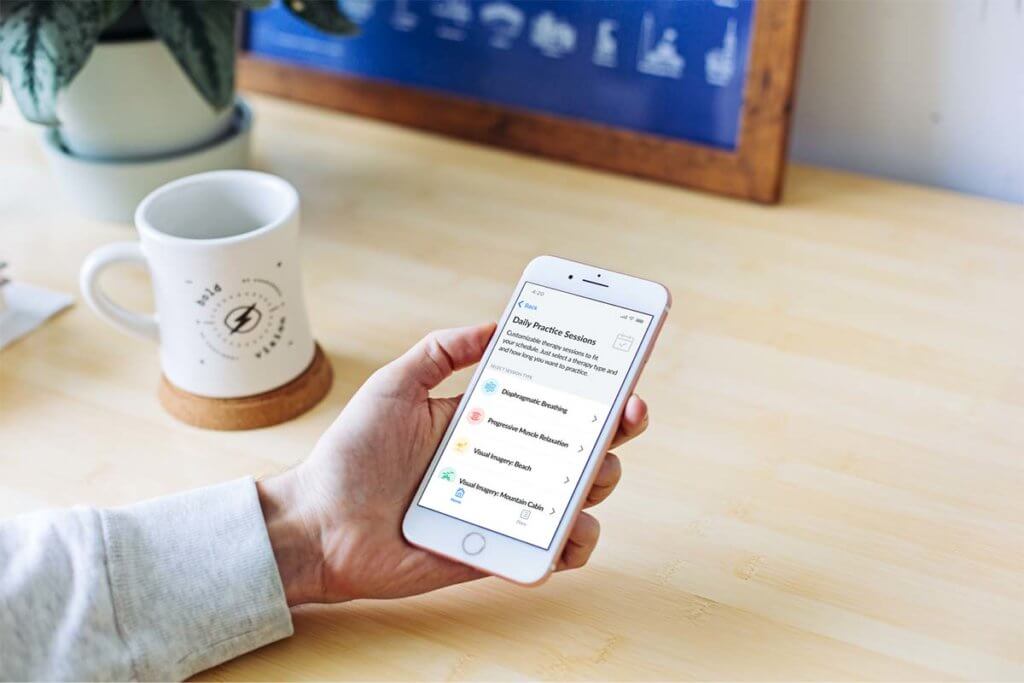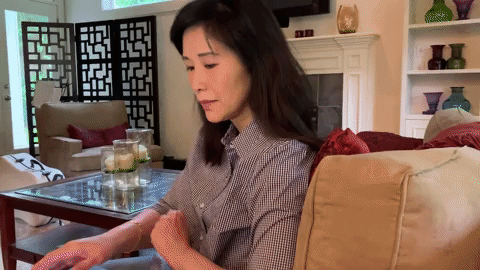Biofeedback is a therapy that helps people learn to recognize and control bodily responses that are often not thought to be within our control, to balance the nervous system, and better manage stress.
Traditional biofeedback is taught in clinics by healthcare professionals using specialized equipment. This equipment can help make you aware of bodily functions you may not feel like are within your control, such as your heart and breathing rate. Then, you are taught techniques on how to control them in order to achieve health benefits, such as reducing the pain and frequency of migraines and headaches.*
Biofeedback therapy is a safe and natural form of migraine management. It can be as effective as medication, but without the harmful side effects. You can use biofeedback alone or in conjunction with medication and other therapies. It’s also safe to do while pregnant or breastfeeding.
Reduction in migraine & attack frequency
Traditional clinic-based biofeedback for migraine prevention has been shown, through many scientific studies, to help provide long-term relief. Following an analysis of the many scientific studies of clinic-based biofeedback for migraine, the US Headache Consortium reports that traditional clinic-based biofeedback is effective for the prevention of migraine and other headache-related disorders [1].
The American Headache Society also included biofeedback in their recommendations for the preventive treatment of migraine in their 2019 guidance [2].
Biofeedback and allied procedures such a relaxation training and practice typically yield a 45% to 60% reduction in headache frequency and severity. Biofeedback can be used alone or combined with medication and other treatments under the guidance of your healthcare professional. For people using medication, the combined effects of medication plus biofeedback are greater than the benefits from medication alone [3].
[1] Campbell JK, Penzien DB, Wall EM. Evidence-based guidelines for migraine headache: behavioral and physical treatments. US Headache Consortium; 2000. Available at: http://www.aan.com.
[2] American Headache Society. The American Headache Society Position Statement On Integrating New Migraine Treatments Into Clinical Practice. Headache. 2019 Jan;59(1):1-18. doi: 10.1111/head.13456.
[3] Holroyd KA, Penzien DB. Pharmacological versus non-pharmacological prophylaxis of recurrent migraine headache: a meta-analytic review of clinical trials. Pain 1990;42:1–13.
Powers SW, Kashikar-Zuck SM, Allen JR, et al. Cognitive behavioral therapy plus amitriptyline for chronic migraine in children and adolescents. JAMA 2013; 310(24):2622–30. 40. Blanchard EB, Andrasik F, N

Juva takes the techniques taught in clinic-based biofeedback and makes them available on your smartphone. It uses your phone’s technology to help make you aware of your bodily functions, like heart rate and respiratory rate, using live recordings of your face or finger.
Juva for Migraine is an app developed by headache experts and healthcare professionals to deliver biofeedback and relaxation coaching similar to what’s performed in headache clinics. Juva trains you to recognize signs of activation and move your nervous system to a state of relaxation, helping reduce migraine pain and frequency.
With Juva, you’ll be guided through techniques for migraine management, such as diaphragmatic breathing, progressive muscle relaxation, and visual imagery. When you practice these techniques, Juva will use your smartphone’s camera as a biofeedback tool to display your biomarkers, so you know how well you are controlling your nervous system.
Practicing these techniques regularly can help you condition your nervous system, relax your body and mind, and promote both short-term and long-term physical and psychological health.
Like any skill, the more that you practice, the better you will become. Practicing 20 minutes every day yields the best results — but we know this isn’t always possible. Practicing for at least 20 minutes, every other day, five or more days per week is also sufficient. The more you’re able to practice, the more likely you’ll experience the benefits of biofeedback.

Tip for success:
NOTE: Juva for Migraine is a coaching app that teaches you relaxation techniques. Relaxation helps with migraine prevention, before an attack. We recommend learning the skills when you are not having a migraine attack. If your attacks occur frequently, try practicing when you are functioning well and able to focus.
Everyone has a different response to the exercises and you will undoubtedly prefer some techniques more than others. We recommend completing all of the seven exercises in Juva’s Therapy Program to learn what’s right for you. You can also talk to your doctor to get guidance on which therapies are best for you.
As you practice, feel free to close your eyes and do whatever you need to immerse yourself in the coaching. Using Juva for Migraine should never feel like a chore. Remember: it’s an opportunity to take time for your body and mind, and improve your psychological and physical health.
After completing Juva’s Biofeedback Coaching, you’ll unlock the opportunity to do Daily Practice Sessions and Games.
Daily Practice Sessions are streamlined sessions to help you focus on the techniques you enjoy most. Juva offers a variety of daily practice session lengths, so you can fit biofeedback practice into your day, no matter what your schedule looks like.
Games are a fun way to test your skills. In these unguided sessions, you can apply the techniques you’ve learned to change different scenes and sounds with your body and mind. Slow your breathing to make a flower bloom. Relax your body and turn the sounds of a storm into a sunny day. See how well you’re able to utilize the techniques and try and master them all.
*While biofeedback therapy conducted in a clinic under the guidance of a professional has been shown to reduce the frequency and severity of migraine, and the Juva app is intended to be similar to clinic-based biofeedback, no studies have yet been conducted on the effectiveness of the Juva app to treat any medical condition. The Juva app is intended to promote general well being and is not intended to treat migraine or any medical condition.